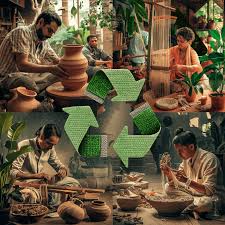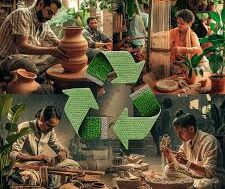Sustainable and Eco-Friendly Handicrafts: Shaping a Greener Future Through Artisan Innovation

Sustainable and Eco-Friendly Handicrafts
The Importance of Sustainability in Modern Craft
In today’s world of fast consumption and mass production, sustainable handicrafts are gaining global recognition. These handcrafted products are not only unique but also reflect a deeper connection to ethical sourcing, environmental stewardship, and cultural heritage. Sustainability in modern craft ensures that artisans minimize environmental harm while preserving age-old traditions for future generations.
How Eco-Friendly Crafts Support Communities and the Planet
Eco-friendly handicrafts are more than just products—they are a means of empowering local communities and protecting the planet. By using natural, biodegradable, and recycled materials, artisans reduce waste and carbon footprints. At the same time, these crafts generate livelihoods for rural creators in regions such as India, Ghana, Nepal, and Kenya, helping them access both local and global markets.
Materials Used in Eco-Friendly Handicrafts
Recycled Materials in Artisan Products
Recycling is at the heart of sustainable handicrafts. Many artisans now craft beautiful items from recycled glass, paper, wood, and metal, giving waste materials a second life. These products appeal to eco-conscious buyers who value creativity and environmental responsibility.
Upcycled Raw Materials and Creative Reuse
Upcycling takes recycling further by transforming discarded materials into products of higher value. From handbags made of textile scraps to jewelry crafted from discarded wood, upcycled handmade crafts showcase how waste can be reimagined into unique, desirable items.
Biodegradable and Natural Resources for Crafting
Eco-friendly artisans rely on biodegradable materials such as bamboo, jute, hemp, banana fiber, coconut shells, and organic cotton. These natural resources not only decompose safely but also reduce dependency on synthetic, harmful materials. Their use also celebrates regional resources, giving identity to every handmade piece.
Zero-Waste Production in Handicrafts
Techniques to Reduce Waste in Artisan Production
Unlike industrial manufacturing, artisans practice low-impact, small-batch production, which minimizes waste. By carefully planning materials and using handcrafting skills, waste is significantly reduced, making traditional crafting more sustainable.
Examples of Circular Economy Practices
The circular economy has become a guiding principle for sustainable artisans. From reusing fabric cuttings to making smaller accessories from leftover wood, artisans ensure that nothing goes to waste. This approach is especially visible in India and Indonesia, where workshops adopt closed-loop systems.
Local Artisans Embracing Zero-Waste Principles
Communities in Nepal, Kenya, and Ghana are embracing zero-waste handicraft models by designing products that reuse or repurpose every scrap of material. These grassroots movements demonstrate how small-scale innovation can contribute to global sustainability goals.
Eco-Certified Handicraft Brands for Global Export
Importance of Eco-Labels and Certifications
Certifications such as Fair Trade, FSC (Forest Stewardship Council), GOTS (Global Organic Textile Standard), and Eco-Cert build consumer trust. These eco-labels guarantee ethical sourcing, sustainable production, and fair wages, which resonate strongly with eco-conscious buyers.
Notable Global Eco-Friendly Handicraft Brands
Brands like Ten Thousand Villages, Artisans du Monde, Selyn (Sri Lanka), and the Green Craft Council are pioneers in promoting eco-certified handicrafts. They bridge the gap between small-scale artisans and international buyers, showcasing the global appeal of ethical crafts.
Opportunities for Exporting Sustainable Crafts
The global market for eco-friendly handicrafts continues to grow, especially in Europe, North America, and Asia-Pacific. With e-commerce platforms, trade fairs, and NGO-backed initiatives, artisans now have greater access to export markets that value handmade eco products.
Challenges and Opportunities in the Eco-Handicraft Industry
Market Demand for Sustainable Artisan Products
The demand for sustainable handicrafts is rising as more consumers shift toward eco-friendly lifestyles. Markets such as fair-trade shops, eco-conscious fashion outlets, and online marketplaces are expanding opportunities for artisans.
Barriers for Small-Scale Artisans
Despite the growing demand, small-scale artisans face barriers such as limited financial resources, lack of certifications, and logistical challenges in accessing global trade. Competition with mass-produced items that falsely claim sustainability also creates difficulties.
Future Opportunities in Eco-Conscious Markets
As eco-conscious consumer segments expand, so do opportunities for artisans. Niche markets such as upcycled handmade crafts, biodegradable design, and ethical fashion accessories are creating space for artisans to innovate and grow in global markets.
The Future of Eco-Friendly Handicrafts
Role of Sustainability in Shaping the Sector
The future of the handicraft industry lies in merging tradition with sustainable innovation. Eco-friendly practices, zero-waste production, and certified supply chains will ensure the long-term success of artisan communities while addressing global environmental challenges.
How Consumers Can Support Eco-Friendly Artisans
Consumers play a vital role by choosing certified eco-friendly handicrafts, supporting local artisan markets, and promoting brands committed to ethical sourcing. Every purchase of a green handicraft contributes to preserving the planet and uplifting artisan livelihoods.
By choosing sustainable and eco-friendly handicrafts, we not only celebrate the beauty of handmade art but also support a greener, fairer, and more inclusive world.
Expanding the Vision: Sustainable and Eco-Friendly Handicrafts in a Global Context
The Cultural Value of Sustainable Handicrafts
Preserving Traditional Knowledge
Eco-friendly handicrafts are not only about sustainability—they also serve as a repository of traditional knowledge and skills. Techniques passed down through generations, such as handloom weaving in India, beadwork in Kenya, and wood carving in Indonesia, represent living cultural heritage. By adapting these crafts with eco-friendly methods, artisans safeguard traditions while aligning with modern sustainability demands.
Craft as a Medium of Storytelling
Every eco-friendly craft tells a story—about the community, culture, and environment it comes from. Whether it’s a basket woven from banana fiber in Uganda or jewelry made from coconut shells in Sri Lanka, these pieces carry the narrative of resilience, innovation, and respect for nature.
Global Trends Driving Eco-Friendly Handicrafts
Rise of Eco-Conscious Consumerism
Across the globe, eco-conscious buyers are making intentional purchases that support sustainable living. Millennials and Gen Z in particular are driving demand for green handicrafts, as they value transparency, ethical sourcing, and eco-certifications.
Integration with Fashion and Lifestyle Markets
Eco-friendly handicrafts are increasingly featured in ethical fashion collections, sustainable home décor, and eco-conscious lifestyle brands. For example, organic cotton scarves, bamboo furniture, and jute handbags have become mainstream eco-luxury items.
Support from Global Trade Platforms
Platforms like Etsy, Fair Trade Certified marketplaces, and global trade fairs are giving artisans direct access to international buyers. This digital shift reduces middlemen and enables artisans to gain fairer returns for their work.
Innovation in Sustainable Handicrafts
Blending Tradition with Modern Design
Modern artisans are blending traditional craft with contemporary aesthetics to appeal to global buyers. For instance, jute rugs are redesigned with minimalist patterns to fit urban lifestyles, while recycled glass is transformed into chic home décor.
Tech-Enabled Craft Entrepreneurship
Technology is revolutionizing the sector. From AI-powered design tools to mobile-first e-commerce apps, artisans now have digital resources to market their products more efficiently. Rural creators in Ghana and Nepal use mobile apps to connect with buyers worldwide, showcasing how technology bridges the gap between local craftsmanship and global demand.
Sustainability as Innovation
The very process of turning waste into high-value crafts represents innovation. Upcycled denim bags, biodegradable cutlery made from bamboo, and recycled paper stationery all demonstrate how eco-friendly handicrafts align with circular economy principles.
Policy and Institutional Support for Eco-Handicrafts
Government Initiatives
Countries like India, Indonesia, and Kenya have established policies to support artisan communities through funding, training, and export incentives. These efforts help local handicraft sectors compete globally while ensuring eco-friendly practices remain central.
NGO and Community-Based Support
Organizations such as Artisans du Monde and Green Craft Council play a vital role in training artisans, providing certifications, and connecting them with ethical markets. Their programs encourage sustainable sourcing, fair trade practices, and environmental conservation.
Role of Certifications in Market Expansion
Certifications like Fair Trade, FSC, GOTS, and Eco-Cert not only guarantee product authenticity but also provide artisans with greater bargaining power in international markets. Consumers are more likely to buy when they see these trusted eco-labels.
Looking Ahead: The Future of Sustainable Handicrafts
The eco-handicraft industry is entering a transformative era. With climate change, deforestation, and overproduction posing threats to global ecosystems, handicrafts rooted in eco-conscious design and ethical production are becoming critical solutions.
In the next decade, we can expect:
- Expansion of global export markets for eco-certified crafts.
- Increased collaboration between artisans, designers, and technology platforms.
- Integration of sustainability goals (SDGs) into craft entrepreneurship.
- Growing recognition of artisans as eco-innovators and cultural ambassadors.
Final Thoughts
The shift toward sustainable and eco-friendly handicrafts highlights the importance of aligning tradition with innovation, culture with commerce, and sustainability with creativity. By supporting eco-artisans, we not only purchase unique handmade items but also contribute to a more ethical and environmentally responsible global economy.
The future of handicrafts belongs to those who embrace zero-waste production, eco-certifications, and creative reuse, while keeping alive the rich traditions of craft-making.
As conscious consumers and entrepreneurs, every choice we make can help empower artisans and protect the planet.
















